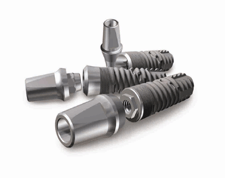المقالات
Lower Jaw

If you have a lower denture, you probably know how hard it can be to eat comfortably. When lower teeth are lost, the bone in the jaw continually recedes. Over time, this causes a lower denture to become loose and floppy. Even worse, there are nerves in the lower jaw that can end up on the surface of the bone. When you bite down, it hurts!
Implants in lower jaw Fortunately, it's usually possible to place implants into the lower jaw so that you can avoid problems associated with dentures. Dental implants are small titanium cylinders that are surgically inserted into the bone of the jaw to replace the roots of missing teeth.
One way to use implants in the lower jaw is to connect the implants with a bar, and then put clips into a new lower denture. These clips snap onto the bar and keep the denture from rocking and shifting. The denture can still be removed at home for easy access and cleaning of the implants and bar. Another option is a lower bridge that may be cemented in or held in place by screws.
Using dental implants to support either a lower denture or bridge will keep the pressure off the bone and the nerves. The implants also help stop the bone loss in the jaw that continues once teeth have been removed. Securing restorations with dental implants can make a world of difference, allowing you to eat, talk, laugh, and smile with confidence again.
Restoring your lower jaw with dental implants is accomplished in two phases. The first phase of the procedure is the surgical placement of the implants. They're under the gums for several months while the bone attaches to them. After healing, the second phase begins. We re-expose the implants and make your new teeth.
For the surgical placement of the implants, your mouth will be thoroughly numbed. Incisions are made in your gums and channels are made in the bone to receive the implants. After the implants are snugly in place, the gums are closed over the implants with a stitch or two each. Over the course of the next few months, the implants become securely attached to the bone.
The second phase starts with surgical re-exposure of the implants. Incisions are again made in your gums and small extensions are placed to bring them above the gum line. We then start a series of appointments to make your new teeth. Though some of the steps might be different in your case, they usually include making impressions of your mouth. From these impressions, we make precise working models of your mouth, which are carefully mounted for proper alignment. It's on these models that your new teeth are fabricated. The last step is the placement of the teeth.
The success of your implants then depends on your care of the implants at home, and on our support through regular checkups and cleanings here in our office.
